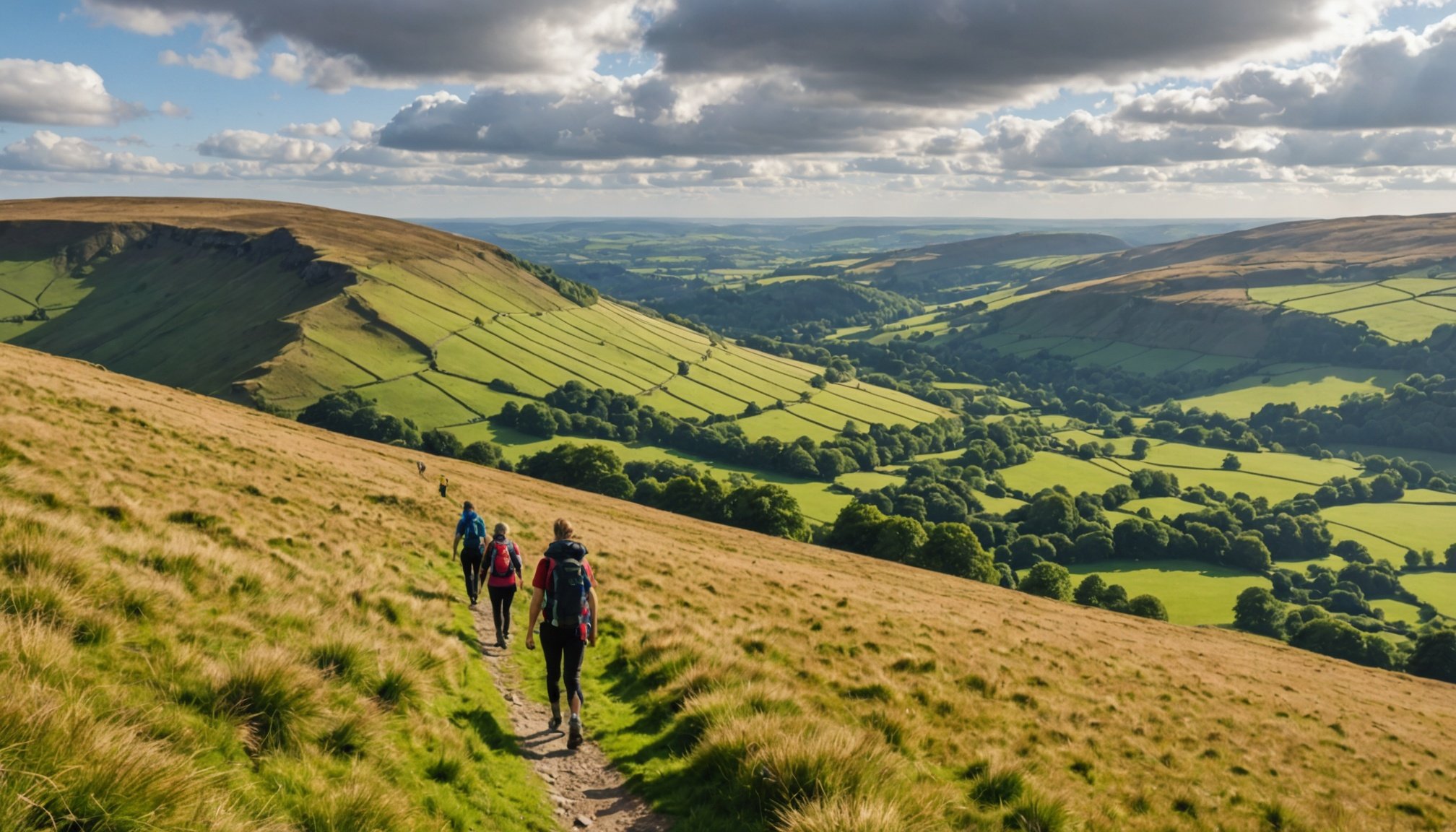Understanding Sustainable Hiking Practices
When embarking on a hiking adventure, incorporating sustainable hiking and eco-friendly practices is crucial for preserving natural environments. Begin by adhering to Leave No Trace principles. These ethics help minimize the impact on wilderness areas by encouraging practices such as packing out all rubbish, sticking to marked trails, and respecting wildlife.
Hiking can significantly impact the environment through soil erosion, disturbance to wildlife, and introduction of invasive species. To reduce these effects, avoid shortcuts that contribute to trail erosion and ensure all camping is done on durable surfaces. Carry a reusable water bottle and minimise single-use plastics to further decrease your ecological footprint.
Topic to read : Uncover bristol”s best artisan markets: your complete guide to local hidden gems!
Being mindful of your ecological footprint not only aids in preserving natural landscapes, but also enhances the overall hiking experience. Equip yourself with sustainable solutions by choosing eco-friendly hiking gear and planning routes carefully to uphold hiking ethics.
Eco-friendly practices extend to post-hike efforts too, such as participating in community clean-ups or engaging with local conservation projects. By integrating these principles into your hiking routine, you contribute positively to the well-being of the areas you explore while ensuring future generations can enjoy these same paths.
Also read : Explore the most instagram-worthy walking trails in the breathtaking yorkshire moors
Recommended Green Hiking Trails in the Peak District
Explore the Peak District through eco-friendly trails that prioritise sustainability and beauty. Nestled in the heart of England, the Peak District offers a range of green hiking routes, showcasing diverse landscapes from limestone dales to dramatic moorlands.
Overview of Eco-Friendly Trails
These trails are designed with nature in mind, minimising ecological impact while providing stunning vistas. Green hiking routes like the famous Monsal Trail and the Pennine Way cater to both novice hikers and seasoned wanderers. They provide a sustainable path through the region’s natural splendor while encouraging the appreciation and preservation of the environment.
Detailed Trail Descriptions
For instance, the Monsal Trail, a repurposed railway path, offers easy access by foot or cycling, promoting sustainable travel. Meanwhile, the challenging Pennine Way stretches over 250 miles, demanding respect for strategic conservation zones. Such paths highlight the importance of eco-friendly trails in reducing trail wear and encouraging low-impact exploring.
Accessibility ranges from easy, walkable paths for families to rugged ascents for adventure seekers. The Peak District ensures that every hiker finds a route that matches their skill level while upholding commitments to sustainability through thoughtfully maintained green hiking routes.
Essential Gear for Eco-Conscious Adventurers
Delving into sustainable hiking gear, it’s crucial to understand the importance of using eco-friendly equipment made from sustainable materials. These include recycled polyester, organic cotton, and plant-based fibres. Opting for such gear not only reduces environmental impact but also aligns with hiking ethics, ensuring that your journeys are as environmentally conscious as they are adventurous.
When selecting equipment, look for brands that prioritise eco-friendly practices. Many companies now focus on reducing waste, conservation of resources, and ethical manufacturing processes. Some noteworthy brands offer gear that is not only sustainable but often more durable, meaning it can withstand the rigours of the trail without frequent replacements.
Durability and repairability play a significant role in maintaining a minimal ecological footprint. Choose equipment designed to last, which can be repaired, rather than replaced. This can reduce landfill waste and promote a culture of conservation. For example, a well-made backpack that can be patched and reused significantly contributes to more sustainable hiking practices.
By investing in durable, reparable gear from reputable brands, hikers can make strides toward personal and environmental sustainability, achieving harmonious adventures with Mother Nature.
Wildlife Conservation and Responsible Hiking
In the realm of wildlife conservation, it’s imperative for hikers to blend exploration with responsibility. Upholding ethical wildlife viewing ensures that our curiosity doesn’t disrupt natural habitats. When you spot wildlife on your journey, maintain a respectful distance, using binoculars or cameras with zoom lenses for a closer look without intruding.
Responsible hiking involves awareness and actions that protect delicate ecosystems. Acknowledge the existence of wildlife habitats by sticking to marked paths and maintaining a controlled noise level. Sudden loud noises can stress animals, disturb their routines, and potentially lead to conflicts.
Hikers play a crucial role in local conservation efforts. Participating in conservation activities like habitat restoration or community cleanup programs amplifies the positive impact of hiking communities. Volunteering with local conservation projects can enhance understanding and foster a deeper connection with natural environments.
To hike responsibly and enjoy the outdoors without compromising wildlife welfare, consider these practices:
- Respect post-breeding areas and nesting sites, which are critical for species’ continuity.
- Educate oneself about local flora and fauna.
- Adopt a “observe but don’t intervene” approach, allowing wildlife interactions to occur naturally and without interference.
Local Environmental Initiatives in the Peak District
The Peak District is home to a range of environmental initiatives aimed at conserving its diverse landscapes. These programs not only preserve natural beauty but also encourage community involvement to bolster local conservation.
Overview of Active Local Conservation Programs
Among the prominent initiatives is the Moors for the Future Partnership. This project works towards restoring the ecology of the moorlands, enhancing biodiversity and addressing climate change impacts. Additionally, the Peak District National Park Authority actively contributes through projects focused on Peak District conservation, supporting habitats and species protection.
Community Involvement and Volunteer Opportunities
These initiatives thrive on community participation. Volunteers are essential to the success of local projects, from habitat restoration to wildlife monitoring. These opportunities foster a hands-on experience in engaging with the natural environment, nurturing a collective sense of responsibility toward the region.
Benefits of Participating
Taking part in local projects not only aids in conservation but also enhances personal connection to the environment. It provides a fulfilling sense of achievement, knowing you’re contributing to the ecological well-being of the Peak District. By actively participating, individuals can witness firsthand the positive outcomes of their actions, fostering a community dedicated to sustainable change.
Visual Aids and Resources for Eco-Friendly Hiking
When planning a sustainable hiking trip, utilising the right hiking resources can enhance your ability to uphold eco-friendly practices. Whether it’s through sustainable hiking maps or innovative tools, hikers can drastically improve their hiking ethics by making informed decisions.
Interactive maps, like the AllTrails app, are instrumental in promoting eco-friendly hiking. These maps highlight established trails and conservation zones, guiding hikers in avoiding areas where flora and fauna might be disturbed. For those who prefer physical resources, printed maps made from recycled materials are a prudent choice.
Visual aids, such as posters and guides, play a vital role in fostering sustainable habits. They can serve as reminders of critical principles like Leave No Trace, encouraging hikers to maintain minimal impact on the natural environment. Apps that offer real-time information about trail conditions and wildlife activity can further support responsible decision-making.
Additionally, informative resources such as online forums and documentaries provide broader insights into eco-friendly hiking while connecting with a community of like-minded adventurers. These tools and resources collectively aid in crafting an environmentally conscious hiking journey, ensuring that natural landscapes are preserved for future explorations.











